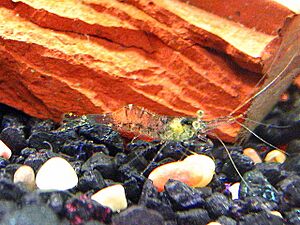Ghost shrimp facts for kids
Quick facts for kids Ghost shrimp |
|
|---|---|
 |
|
| In a freshwater aquarium | |
| Scientific classification | |
| Synonyms | |
|
List
|
Palaemonetes paludosus, commonly known as ghost shrimp, glass shrimp, or eastern grass shrimp, is a type of small, clear shrimp that lives in freshwater. You can find them in the southeastern United States. These amazing creatures are super important to their homes, like a "keystone" that holds everything together! They're also quite popular as pets in home aquariums.
Contents
What Do Ghost Shrimp Look Like?
Ghost shrimp are usually about 2.5 centimeters (1 inch) long. They are mostly see-through, which helps them hide. They can even change how their body colors look by moving tiny color spots around. This helps them blend in perfectly with their surroundings, making them very good at camouflage. They look a lot like another type of shrimp called Palaemon kadiakensis, but scientists can tell them apart by looking closely at their tails.
Where Do Ghost Shrimp Live?
You'll find Palaemonetes paludosus commonly in the southern states of the United States, especially east of the Appalachian Mountains. They are also found in Louisiana, and sometimes in Texas and California. These shrimp often live in places with lots of plants, like Polygonum beds. The plants help them hide from animals that might want to eat them.
Ghost Shrimp in Their Habitat
Ghost shrimp live in fresh water or water that's just a little bit salty, often in lakes. They are nocturnal, meaning they are most active at night. During the day, they stay hidden among plants. At night, they come out to eat tiny floating creatures called plankton.
These shrimp are an important food source for many birds and fishes, like black bass. Because they play such a big role in the food chain and their environment, they are considered a keystone species. This means they are very important for the health of their habitat.
Sometimes, ghost shrimp can be affected by a tiny parasite called Probopyrus pandalicola. This parasite can change how the shrimp grow and affect their ability to have babies.
Reproduction and Life Cycle
Ghost shrimp are a polygynous species, which means one male shrimp will mate with more than one female. In the wild, there are usually more females than males. A female shrimp can lay up to 85 eggs at one time!
Their breeding season depends on how warm the water is. After the females lay their eggs and the babies hatch, the adult shrimp usually die. This completes their life cycle.
What Do Ghost Shrimp Eat?
Ghost shrimp are omnivores, which means they eat both plants and animals. Their main diet includes algae and small aquatic insects. They also enjoy eating different kinds of tiny plant-like organisms called diatoms, such as Fragilaria and Nivicula. Since they are nocturnal, they do most of their eating at night.
Ghost Shrimp as Pets
Ghost shrimp are popular pets for home aquariums because they look unique and are easy to care for. They are a great choice for people who are just starting with aquariums. These shrimp help keep the tank clean by eating algae and any leftover food from other tank animals.
It's best to keep ghost shrimp in a group. About 20 shrimp can live happily in a 5-gallon tank. A good rule of thumb is to have about three shrimp for every gallon of water in your tank.

